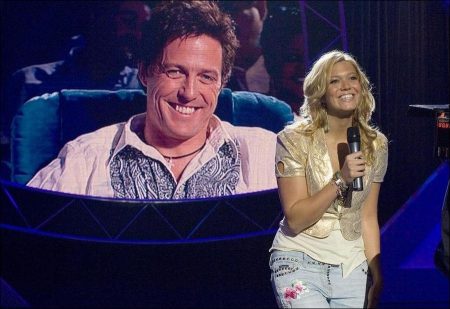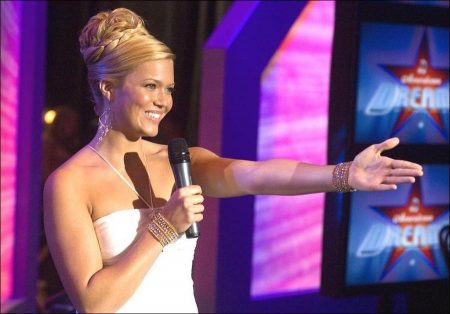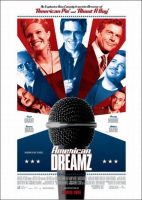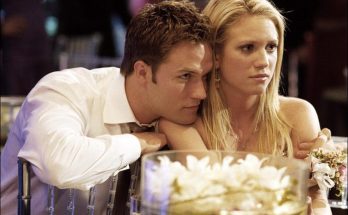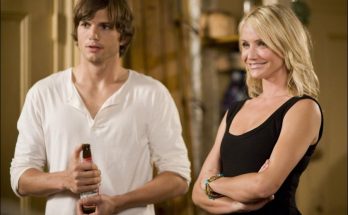In the future, everyone will be world-famous for 15 minutes. – Andy Warhol, Pop Culture Icon
In the world of right-now, it seems as if literally everybody wants to be famous. And thanks to the global phenomenon of “reality” television, literally anyone can be.
Take self-aggrandizing host of the runaway American hit TV show entitled “American Dreamz,” Martin Tweed (Hugh Grant). Tweed’s concept is a flashy reworking of the talent search formula: pit eager contestants against each other (talent sometimes notwithstanding) and televise their weekly battles to win judges’ votes. In his all-out attempt to capture fickle television viewers and stay atop the network ratings’ heap, Tweed has done anything and everything necessary to keep his show’s popularity-and this season, he’s just about to reach new heights.
The delicious new crop of aspiring “Dreamz” finalists includes such hopefuls as Sally (Mandy Moore), a Southern belle who’s sugar and spice in front of the cameras, and Omer, an incompetent would-be terrorist who’s fond of Broadway show tunes.
Add to the mix Sally’s puppet of a boyfriend-the dopey young veteran William Williams (Chris Klein)-and a cadre of equally colorful groupies, network types, cultural pundits and strategizing politicos. And as if that weren’t enough, Tweed has secured the President of the United States (Dennis Quaid) to serve as a special guest judge in the final installment of the season… setting the stage for an explosive show the nation will never forget. Here comes the future, where fame is ready made for those willing to do anything to get it.
Synopsis of the Film
“Everyone in America thinks they’re middle class, so they like having someone to look down on.” – Hollywood agent Chet Krogl
As a nation, America just can’t seem to get enough of the talent show “American Dreamz.” The weekly program, a TV ratings juggernaut, has seized a country that is now addicted to its regular fix of “who’s in and who’s out.” The brainchild of self-promoting, self-loathing Martin Tweed (Hugh Grant), the show’s host is ever on the lookout for the next insta-celebrity.
Tired of the same boring guests season after season, Tweed decides to up this year’s ante by recruiting a crop of bizarre hopefuls that includes Sally (Mandy Moore), a conniving steel magnolia with a devoted, dopey veteran boyfriend (Chris Klein) and fame-obsessed mom/manager Martha (Jennifer Coolidge); Omer (Sam Golzari), a recent immigrant and bumbling, Broadway show tune-singing / would-be terrorist awaiting activation; and Sholem (Adam Busch), an Orthodox cantor whose goofy raps were tailor-made for unscripted television. And as if that weren’t enough, Tweed has booked the actual President of the United States, Joe Staton (Dennis Quaid)-pushed into the gig by his Chief of Staff (Willem Dafoe) and supported by his First Lady (Marcia Gay Harden)-to sit in as a guest judge on the final showdown, broadcast live to the biggest ratings yet…or so Tweed expects.
Sally is guided to the final round by Tweed, his show producers Accordo and Ittles (Judy Greer and John Cho) and her morally bankrupt agent Chet (Seth Meyers). During her weekly-televised ascent, she manages to claw her way to the center of the nation’s conscience-only to find her path to winning “American Dreamz” threatened by lovable immigrant Omer.
A reluctant contestant who just wants to fit in his new home country, Omer is told by his secret terrorist training camp operatives to make his way to the finals. Once he’s within arm’s reach of the winner’s circle, he’s to detonate a bomb that will destroy guest judge President Staton (who’s there to boost his own sagging approval ratings) and simultaneously strike a symbolic blow to hedonistic American culture.
With everything riding on the biggest show of the year for Tweed, President Staton and the two hopefuls, the stage is finally set for an explosive showdown the pop-fed nation will never forget.
Dreaming American Dreamz: Paul Weitz Finds Inspiration
“So to what degree is this country culpable for its actions? Are Americans to blame for America?” – “American Dreamz” hopeful / bumbling terrorist Omer
For filmmaker Paul Weitz, the genesis of his latest project began with a vexing idea: unfulfilled dreams. He reflects, “I was interested in making a film about a core aspect of the American identity-the idea that we are all supposed to have a dream. We’re supposed to want something better than what we actually have.”
So, the writer put pen to paper and wrote “an utterly insane comedy about the idea that everybody in America has a dream-and how that `great thing’ can actually drive our culture crazy.”
Long curious about the roots of quirky human behavior and its comic potential, Weitz and his team at Depth of Field Productions found the concept for a satirical film familiar territory. They had previously tackled social issues in the comedy of the American Pie franchise, About a Boy and In Good Company. But the often bizarre social and political climate of the past few years had left the filmmakers pondering an even more arresting theme: the shifting nature of “reality” viewed as entertainment while “real” reality threatens to erode into chaos.
“Part of the inspiration for the film was my fascination with pop culture and `American Idol’-the juxtaposition of being interested and obsessed with the show while world events become more crazy,” notes Weitz.
Reassembling much of the crew who had brought life to his previous films, Weitz turned to trusted producers Andrew Miano and Rodney Liber to bring American Dreamz from his page to the screen.
Producer Miano-who originally partnered with the Weitz brothers in 1999 and subsequently joined them under the shingle of Depth of Field-surmises that Weitz “wanted to make a film that looked at our cultural obsessions. He wanted to write a story with both a political and a pop-culture slant.”
From inspiration to completion, Weitz didn’t waste any time. Producer Liber recalls his early conversations with Weitz in discussing American Dreamz as, “Paul wanted to get going on it right away so that it would be out when it was still timely. From the time he first told me about this movie to the time we were greenlit and in preproduction was two months.”
Miano echoes how Weitz’s clear vision is emblematic of how he works. “He comes up with the idea, he puts pen to paper and the next thing you know, there’s a script.”
“With Paul, it’s like one-stop shopping,” concludes Liber. “Because he’s the writer, producer and director, I can come to him with any potential problem, and he’ll be able to solve it just by going to his computer, retyping or rethinking a scene and coming up with solutions that are sometimes even better than what they were originally.”
With working script in hand, Weitz and his team were ready to cast the film. All they needed to find was a band of actors willing to deliver sarcastic lines with the best of poker faces.
Actual of a Fixed Show: The Stars of American Dreamz
“I’d rather jab my eyes out with a toothpick and eat them than lose this thing.” – “American Dreamz” contestant Sally Kendoo
Many of the cast members of the film are veterans of Paul and Chris Weitz projects and expressed great interest in working with the brothers again. Weitz recalls of casting his troupe of actors: “It was like a fever dream-all these people I knew doing these crazy characters.”
Hugh Grant starred as Will, the self-involved bachelor who finally grows up with the help of a young boy, in the Weitz brothers’ film version of Nick Hornby’s best-selling novel About a Boy. Academy Award nominated for best screenplay adaptation, About a Boy was co-written and co-directed by Paul and Chris Weitz.
Weitz relates, “I sent Hugh the script, and I think he was upset when he read it and actually was intrigued by it. Hugh has a very cynical, acid sense of humor and uses that to its fullest extent in this film.”
The concept of the film was one that amused Grant at every turn. “The blackness of this script very much appealed to me. But what makes it work is that it’s done with a strange kind of affection and warmth.”
Commenting on working with the director, Grant offers, “Paul’s always been in tune with my darker side. He is kind of amused by it. He told me that he put a certain amount of that darkness and existential angst into this part, so I felt it was quite a juicy thing to come and actually play it out on screen.”
Also an easy character sell, American President Joe Staton was cast during a single conversation between Dennis Quaid-star of the Weitz’s critically acclaimed film In Good Company-and Paul Weitz.
“He just asked me to do it,” recalls Quaid. “He wanted me to play the President, and I just said, `Yes’-without even reading the script. He’s so talented, and I want to hitch myself up to his wagon.
“Paul can be satirical, but all of his material has a heart to it as well,” observes Quaid. “It doesn’t drift into caricature, and it’s not mean-spirited. The President is a guy with a heart that makes him an interesting character, and I was more interested in portraying the difference between the public and the personal persona of the man.”
Of creating his character, Quaid comments, “I didn’t want to do an impersonation of anyone. I wanted to put in a little flavor of Bush but also have President Staton be his own man. And there’s a little bit of Reagan and Clinton and presidents I’ve watched over the years.”
The director agrees with Quaid’s take on the role: “Dennis brings a lot of heart to whatever he does, so this would have been boring if he had just done a parody of Bush.”
Actress and singer Mandy Moore was cast to play the manipulative Sally Kendoo, who uses all her talents to make it to the finals in this latest season of “American Dreamz.”
Weitz laughs, “Sally is basically a sociopath. She desperately wants to be a star.”
The filmmaker needed to find an actor who could play very sweet with a very naughty side, and that actor was Moore. “I wanted Mandy because I actually believe she could win `American Dreamz,’ he says. “There’s something very sweet about her, and it makes it very interesting to see her in a villainess role.”
“When I was preparing for the film,” shares Moore, “I was thinking, `This is a girl who has watched every season of the show. She knows everything about Martin Tweed.’ So when she makes it to the opening round and gets chosen to go to Hollywood, she has it all planned out, every step of the way.”
Supporting and encouraging Sally as she pursues her dream are her on-again/off-again boyfriend William Williams, devoted stage mother Martha Kendoo and her win-at-any-cost agent Chet Krogl. Jennifer Coolidge plays the somewhat overbearing, yet supportive mom Martha; Chris Klein, Weitz’s do-gooder jock from the American Pie films, portrays William-Sally’s wounded-war-veteran and dim-witted beau-and Seth Meyers steps in as Sally’s agent Chet.
To Klein, while the character of William Williams is as all-American as you could possibly get, he is also very determined. “William will do whatever it takes to get what he wants,” the actor comments. “All these characters will, and I love that.”
Weitz feels Klein’s character encapsulates his film’s message that “Everybody is consumed by a dream here-for better or worse. He’s fixating on this girl who clearly doesn’t care for him…thinking his love for her is going to overcome everything.”
Oscar winner Marcia Gay Harden takes a refreshing comic turn as the salt-of-the-earth First Lady to Dennis Quaid’s President Staton, while veteran thespian Willem Dafoe dives into the role-and offers an uncanny resemblance to a certain administration official-as the manipulative Chief of Staff who just wants the President to behave as he did in his first term: completely clueless.
Adding a unique spin to American Dreamz is Weitz’s core group of newcomers, including Sam Golzari as Omer, Tony Yalda as Iqbal, Noureen DeWulf as Shazzy and Adam Busch as Sholem. The young actors bring to his film the spirit of a tried-and-true Paul Weitz technique: mixing it up with old- and new-school performers.
“One of the big thrills for me in filmmaking is to take people who’ve done absolutely nothing in movies and put them with people who are incredibly well-known film stars,” the director says. “It points to the fact that acting is an amazing talent, and it doesn’t matter if you’ve done it a hundred times or are doing it for the first time.”
Golzari and Yalda had an especially difficult task at hand: playing starry-eyed talent show hopefuls. The Svengali to Omer’s aspiring reality star, Iqbal needed to be as talentless as he was hilarious. Yalda jokingly explains of his self-centered Iqbal, “I’m playing a character of Middle Eastern descent that actually is rich, a little bit conceited and wrapped up in his own world. I thought it was me…except for the rich part.”
Weitz knew for the character of his bumbling terrorist Omer, he had to cast a young man with both deep wisdom in his fresh face and great comic timing; he found that in Golzari. Omer was perhaps the most changed of the `American Dreamz’ hopefuls-from his experience training at (and singing show-tunes in) a terrorist camp in the Middle East to living the American dream in Orange County…and becoming cast on one of the world’s most popular reality shows.
Sam Golzari suggests, “When describing Omer, the word `terrorist’ just feels so weird to me; I don’t see him like that. It was exciting for me to play a guy who is more than a simple terrorist. I saw Omer more as a good kid getting mixed up with a gang. He had made some really bad choices, but in the end has a good heart.”
Of Golzari’s performance as Omer on the talent show, Weitz notes, “The first (song) he sings is `Impossible Dream,’ which has a whole different light when it’s being sung by a terrorist, as there are lines in it talking about marching into hell for a heavenly cause-which seems to be how some of these people define themselves. (To them), their causes are so worthwhile that you can utterly suspend the semblances of morality.”
Glued to Tube: The Cast and Crew Dissect Reality Television
“I’m talking human. And by human I mean flawed. And by flawed I mean freaks. Find me some freaks.” – “American Dreamz” host Martin Tweed
In signing up for the project, the cast and crew were forced to reflect on questions such as, “Why are we watching these shows? Why are so many Americans enthralled with cheering for their favorites: for the underdog, for the most deserving, for the most talented? Is it a fad, or is there something deeper behind it?”
Notes Weitz, “Part of the appeal of `American Idol’ or in this show `American Dreamz’ is the idea that we can take somebody and make a star out of them. There’s nothing better than sitting in the comfort of your living room and not dealing with your problems…and being thrown into the deepest desires of real people. Everybody in some way is consumed by a dream here, for better or for worse.”
The filmmakers and the cast offered multiple views and theories about why reality television has come to occupy the country’s-and world’s-attention. Hugh Grant offers, “I don’t want to know that these shows are somewhat staged, just so long as it’s fascinatingly repellant-that’s all I care about. I think if I had a choice between having dinner with someone who is a completely worthless reality TV star or Hollywood royalty, I’d go for the worthless reality TV star every time. They’re more interesting.”
Mandy Moore adds, “Reality shows provide the escapism we crave. I feel these shows are like sporting events without actual athletes. People who aren’t into sports can tune in every week and vote to keep their people in the playoffs and then, hopefully, get down to the finals. It’s perfect.”
“I really think that everybody wants to root for something…everybody loves it,” actor Chris Klein notes. “Why do people go to baseball games and NASCAR races? It’s (to watch) people striving to do their best while others root them on.”
Tony Yalda takes a different perspective on the “rooting them on” aspect of the show…feeling it can often come from a more competitive place. He says, “When we watch `American Idol,’ we love tuning into the horrible auditions and delude ourselves by thinking, `Yes, they’re awful, and I’m better than they are.’”
Jennifer Coolidge reflects, “I think what happened for a lot of people was that reality television seemed to offer something refreshing and real. The reality shows were actually more real, truer to people than the absurd sitcom. You can tune into a reality show and feel, `Oh, my God, this is real.’ But now, we have come the full spectrum to a place where a lot of the reality shows are not so real.”
Comic Seth Meyers simply wishes he “could figure it out. It’s so beyond me how riveted we are by it, because I find it very uncomfortable to watch real people being real somewhere other than in regular life. So, I think I’m sort of on the outside looking in on this reality phenomenon.”
Sam Golzari agrees, “It’s amazing living in and working in Hollywood. You quickly find out what reality shows are actually like, with these shows about Hollywood and the dreamers in it. When you air that around the world, specifically the Middle East, people think it’s real-the American dream.”
The backdrop of a reality set allowed Weitz to play out his characters’ storylines quite well. He found that not only is a home audience strangely affected by reality programs, but so too are the players on the set. Weitz concludes, “There’s a scene in the finale of the show where the President is giving a completely pat, imbecilic speech about how he likes how the contestants exude what’s best about America. They see what they want and they go for it.
“It’s the kind of speech that one would totally gloss over,” he continues. “But backstage, Omer, who’s deciding whether to blow himself up is hearing this speech, and it has tremendous meaning to him. It’s at this point he makes his decision about whether or not to go through with the plot.”
Cover Your Eyes: The Music of American Dreamz
“If these people know nothing about talent, there’s not much I can do about it, is there?” – “American Dreamz” hopeful Iqbal Riza
To capture the essence of an “American Idol”-type competition, the music of American Dreamz needed to replicate the uninspired compositions often sung by many of the amateur performers on the actual singing contests that have become sensations in countries around the world.
To write some original “bad” songs for the “American Dreamz” competitions, the filmmakers brought in composer Stephen Trask (Hedwig and the Angry Inch), with whom they had previously worked on In Good Company. To get in the appropriate mindset, Trask proceeded to immerse himself in musical styles that were most definitely not to his taste. By listening to and studying gooey pop music, he felt he would be able to find inspiration for creating lyrics and music that wouldn’t be just bad, but believably bad.
“It was very embarrassing,” laughs Trask. “When I would go to the record store where I regularly shop, I actually felt compelled to explain what I was doing. It was just too humiliating to be buying all this really popular, disposable pop.”
Trask found that the contestants on each season of the hit series “American Idol” chose the same pop song selections time and again. Shockingly, the audience listening and voting for their favorite “Idol” contestants never seemed to tire of the same sentimental tunes.
“I tried to get inside a songwriting style and to write well…but from somebody else’s instincts,” remembers Trask. “The idea was not to write badly, but to write well from what I think of as bad instincts.”
Relying on this method to compose a song proved to be difficult for the composer, and there were many times when he had to toss away a composition because it was just too good. “When I brought the first draft of `Rockin’ Man’ (sung by a spoofed long-haired rocker in the film) to play for Paul,” the composer shares, “his first comment was that it was great. And he was right, it was too good.”
To aid in reviving his “bad” instincts, Trask went through popular song titles and started noticing that many infamous pop-rock titles were not only pedestrian, the songs lyrics were repetitive. For example, he found the compositions including “I’ll Never Stop Loving You,” “I’ve Never Felt This Way Before” and “You Are My Life” managed redundant phrases that stretched over the same melodies, again and again-perfect for what Trask needed to accomplish.
As producer Liber was trying to figure out how the very expensive proposition of retaining the rights to many well-known songs would fit into the film’s budget, Trask surprised Liber by suggesting an unconventional partner who would alleviate costs and help in writing some of the tunes: Paul Weitz.
Weitz assured Liber that he would help write the songs and meet their production deadline. The skeptical producer gave Weitz and Trask eight weeks to write, and, in typical fashion, they were done on time.
“We wrote, `Let’s Not Be Friends’ together,” Trask relates. “It started off with some lines that Paul was just singing-a simple melody and lyrics. We also wrote `Mommy Don’t Drink Me to Bed Tonight,’ as well as `Rockin’ Man’-which is sure to be a Grammy winner…”
Weitz and Trask felt anything too original would have been inappropriate for the film. To continue the emphasis on all things plain, all three songs were given an almost identical instrumentation-the same sounds, the same big snare with the never-ending reverberation and the same sax solo.
Luckily, the Depth of Field team had some actual vocal talent with whom to work: the multitalented Mandy Moore. Weitz reflects of his chanteuse as the irrepressible Sally Kendoo: “I knew Mandy was a pop star, but I had no idea if she could actually sing, or if a 50-year-old soul singer was doubling for her voice. And then she came in and recorded Steven’s “Dreamz With a Z,” and I realized she had just an incredible voice.”
Designing Dreamz: Costumes and Sets of the Film
“I kinda remember it. I was pretty toasted.” – American President Joe Staton
Like many of the cast members, the majority of the creative team gathered by the filmmakers were veterans of at least one previous Weitz project. “Paul is extremely loyal,” explains Liber. “And he also has a comfort level with familiar, creative people. So the first thing I did was to go to people who had worked on In Good Company, and I tried to establish who was available.”
“It’s always good to get a repeat call,” begins production designer William Arnold, “I had a very good experience on In Good Company and just expected the same sort of thing on this one-and it was. I think Paul likes to have a comfort level on his sets; when he finds people who do that, he tries to keep them all together.”
Production was based at the Los Angeles Center Stages in downtown Los Angeles, where several sets were built-including the game-show set of “American Dreamz” as well as the President’s bedroom. Other location work in and around Los Angeles was completed in Sierra Madre, Thousand Oaks, West Hills and at The Ritz Carlton hotel in Pasadena.
Before launching into action, each department head met with Weitz. The comprehensive discussions clarified the production values he wished to create as the backdrop for the story. As costumer Molly Maginnis explains, “We talked about each character in-depth-where they’re from, what their desires are, what they want to put across.”
The “American Dreamz” show set and the costumes worn by each of the contestants was one of the most challenging elements of the film. The set was “all played a little over the top, a little past reality,” explains Arnold.
Gathering inspiration from “American Idol,” Arnold looked not so much to copy the sets, but to draw elements from the show that would translate well into film. “These shows are seen through the television set, and they’re manipulated just from that point of view. To just repeat that on film would not work. We saw what tricks they used and tried to utilize and adjust a few of them to our medium.”
The set of “American Dreamz” was designed with large, dramatic, freestanding geometric figures that could be lighted in a myriad of ways. It also included several video monitors of various sizes, on which images and colors could be constantly manipulated and adjusted.
The other major set designed and built was the President’s bedroom. This too was built at the Los Angeles Center Studios and was the scene of many of the most important exchanges among Dennis Quaid, Marcia Gay Harden and Willem Dafoe.
The production designer found it quite difficult to get accurate information about the private residence areas of the White House. “But I knew that I wanted it to feel like the room could be in the White House and yet still convey that we are in a different reality,” he remarks. “Everything in it-the moldings, the furniture-is a little over-scale. This way the actors look a little smaller, a little more childlike in that set.”
Costumer Maginnis not only worked in conjunction with Arnold and his team to make sure that the color palettes were compatible with the costumes she designed, but she had to be very aware of the lighting components that cinematographer Robert Elswit was planning to use to highlight the elements of each scene. Working as part of this creative team, Maginnis met constantly with the others to ensure that each costume would work in sync with the other visual elements.
“We would go through the sets and the colors just to make sure that the contestants were not in the same, exact colors. We had technical rehearsals where we did the show within the show. During this time, we brought costumes in so that DP Robert Elswit could look at the clothes with Paul and they could decide if the colors were going to work. It also gave Robert a chance to work with his crew to adjust the lights, as needed.”
Dressing Mandy Moore as Sally was the most fun for Maginnis. “We wanted Mandy to look as adorable as she always does. But at the same time, we wanted to show that Sally is reading People and In Style, she’s looking at all these things she’s trying to work into her act. After all, Sally is a very savvy girl about where she wants to be; but where she’s come from-that has some limitations for her.”
Typical of the “American Idol” contestants, as each singer moves up the ranks and to the next level within the contest, their appearances so change. The production team felt this would also be important for the film’s hopefuls.
“As they move along, stylists start working with the contestants,” observes Maginnis. “I’d look at what some of these kids would wear. Basically, they are in jeans and a t-shirt when they start. By the end, they’re wearing chiffon gowns with tiaras and rhinestone shoes. It’s pretty hilarious-so we couldn’t go too far.”
Working with Moore to create a progressive look for Sally was gratifying for both the costumer and the actor. “Mandy was willing to have fun with it. She would say, `Let’s go. Let’s make it even more funny.’”
Moore reflects, “I think Sally was reeled into the whole experience. Someone was leading her around, letting her shop and helping her pick out clothes. They were telling her what lip gloss looked best…how to wear her hair so that it looked the best for TV. By the end of it, she’s so polished, and she knows exactly what she’s doing and what to wear-a dangly earring, or a rhinestone cuff or some sort of bejeweled necklace.”
Planning out what the bumbling, would-be terrorist Omer would wear as he climbed the “American Dreamz” ladder into the finals was equally challenging for Maginnis. Omer is heavily influenced by his cousins Shazzy and Iqbal and their love of all things MTV-ish. Keeping this in mind, Maginnis had an open canvas to create his look utilizing bright colors and surprising textures. Again, the more exaggerated his look, the better to represent his Orange County influences.
“When his cousins get a hold of him, they just completely subvert his plain style and give him some flash. For his song, “Impossible Dream” we used a corny-looking spandex jacket with the epaulets, so it has kind of a military feel to match the marching sound of the music. It is almost like a marching band uniform.”
With the reality show players dressed, choreographed and as “well” tuned as possible, Weitz knew it was time for his season of “American Dreamz” to commence-and some of his characters’ to prepare for their nasty swan song. The filmmaker closes with his summation of President Staton’s final revelation of the film: “Staton finally realizes, `I think that we are all looking for solutions to these problems, but maybe there aren’t gonna be any. Maybe, we need to address how to keep the elements down. Maybe it’s gonna be the kind of thing where the problem needs to be contained as opposed to solved.’”
Until then, it seems we’ll just keep singing and dancing our hearts out…Nero fiddling while Rome burns.
American Dreamz (2006)
Directed by: Paul Weitz
Starring: Hugh Grant, Dennis Quaid, Mandy Moore, Marcia Gay Harden, Chris Klein, Jennifer Coolidge, Sam Golzari, Willem Dafoe, Seth Meyers, Judy Greer, Noureen DeWulf, Shohreh Aghdashloo
Screenplay by: Paul Weitz
Production Design by: William Arnold
Cinematography by: Robert Elswit
Film Editing by: Myron I. Kerstein
Costume Design by: Molly Maginnis
Set Decoration by: David Smith
Art Direction by: Sue Chan
Music by: Stephen Trask
MPAA Rating: PG-13 for brief strong language and sexual references.
Distributed by: Universal Pictures
Release Date: April 21, 2006
Visits: 76
